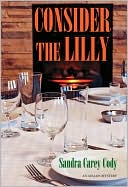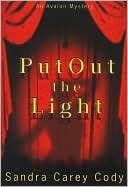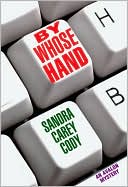Authors of the Month
Sandra Carey Cody [Dec
2010]
Chosen by MyShelf.Com reviewer Carmen
Ferreiro-Esteban, Ph.D.
 Sandra Carey Cody
is the author of the Jennie Connors mystery series, published by Avalon
Books. Put Out the Light, Consider the Lilly and By Whose
Hand are currently available in book stores and libraries. These
stories explore the challenges facing a single mother as she learns to
balance independence with family and career responsibilities.
Sandra Carey Cody
is the author of the Jennie Connors mystery series, published by Avalon
Books. Put Out the Light, Consider the Lilly and By Whose
Hand are currently available in book stores and libraries. These
stories explore the challenges facing a single mother as she learns to
balance independence with family and career responsibilities.
Sandy’s latest novel, Love and Not Destroy, examines the
ways in which destiny is shaped by family secrets. It is set in a museum
of antique tools and folk art in a small town near Philadelphia. The new
protagonist is Peace Morrow, a young woman who was found in a basket as
an infant. Twenty-two years later, a homeless man is murdered in exactly
the same spot. Peace can’t believe it’s a coincidence and
thus begins a search for identify that explores the nature of family,
of loyalty and responsibility.
I met Sandra two years ago at a book signing event, in that small town
near Philadelphia where her new novel takes place. In between signing
our books and talking to the readers, we shared our experiences in the
writing world and became friends.
Today Sandra has been kind enough to answer in writing and in more detail
what we shared that day. I am certain her detailed explanations of her
writing process will interest readers and inspire aspiring writers.
As always, her love for her characters and her trade shines through her
answers.
I hope you enjoy reading the interview as much as I did recording it.
Interview
 Carmen: When
did you first know you wanted to be a writer?
Carmen: When
did you first know you wanted to be a writer?
Sandra: Not until I was well into my adult years. Ever since
I can remember, I’ve had stories and bits of dialogue going on in
my head, but they were my private world and it didn’t occur to me
to share them with anyone else. I’ve loved books for as long as
I can remember, but I had to reach a certain age to realize that they
are written by ordinary people – people like me.
Carmen: What part of writing do you most enjoy?
Sandra: Making up the characters. I have a wonderful time inventing
imaginary people, figuring out what they look like, what their hopes and
dreams are, what they are afraid of, what kind of secrets they’re
hiding. I love to create contrasting characters and play them off each
other. It’s like doodling – pure fun.
Carmen: What part do you least enjoy?
Sandra: Plotting. There’s no doodling here. It takes hard, concentrated
effort to come up with adventures for the people I’ve created. Somewhere
along the way, I become so attached to them that it’s hard to make
bad things happen to them and, of course, without bad things, there’s
no story. I’m happy to say, however, this is becoming easier. I’m
gradually learning to enjoy plotting. It’s not pure fun, but it’s
no longer pure torture. I still think it’s the hardest part of writing.
Carmen: What comes first? Characters? Story? Setting?
Sandra: I start with my characters, usually one specific person, then
move on to the people who surround this individual – family, friends,
co-workers. Setting is next; it grows out of some aspect of the cast of
characters. Where would these people be? What would bring them together?
I have to say, though, that in my latest novel, To Love and Not Destroy,
setting came first. There’s a wonderful castle-like museum in the
town where I live and I had to write about it. Story comes last because
the plot follows the characters. Their secrets, fears, hopes and dreams
shape the story. Their reactions to other characters and the situations
in which they find themselves result in a series of actions that become
the plot.
Carmen: Where do you find inspiration?
Sandra: Everywhere: people in the supermarket, an old man walking
a dog, a single leaf clinging to an otherwise bare tree, the museum mentioned
above, funny things my friends say and do. Nature, especially this time
of year. The newspaper is a gold mine of ideas. Inspiration isn’t
a problem. Discipline to shape inspiration into a story – that can
be a problem.
Carmen: Tell us about your Riverview Manor mysteries.
Sandra: The published books in the series are Put Out the
Light, Consider the Lilly and By Whose Hand. Left at Oz,
the prequel to the other books is scheduled for release in mid-2011. Avalon
Books is the publisher. There’s a brief description of the books
on my website: www.sandracareycody.com
 The
stories are set in a retirement community and explore the challenges facing
a single mother as she learns to balance her newfound independence with
family and career responsibilities. My protagonist, Jennie Connors, is
Activities Director in this surprisingly quirky place. Her job is to keep
the residents busy, happy and out of trouble. She is a single mother with
two young sons and an ex-husband she doesn’t hate. Here, I wanted
to go against stereotype and show two good people who couldn’t make
their marriage work, but are determined that their children not be damaged
by their choices. This doesn’t mean sparks never fly between the
two. The residents play a large part in the books. Again, I wanted to
go against stereotype – no boring old people sitting around talking
about the good old days. The folks at Riverview are smart, curious and
just bored enough to stir up trouble. I have a great time making up a
history for each of them and giving them unique experiences and personalities
that come into play when the occasional murder needs to be solved. I enjoy
the interaction between the different generations.
The
stories are set in a retirement community and explore the challenges facing
a single mother as she learns to balance her newfound independence with
family and career responsibilities. My protagonist, Jennie Connors, is
Activities Director in this surprisingly quirky place. Her job is to keep
the residents busy, happy and out of trouble. She is a single mother with
two young sons and an ex-husband she doesn’t hate. Here, I wanted
to go against stereotype and show two good people who couldn’t make
their marriage work, but are determined that their children not be damaged
by their choices. This doesn’t mean sparks never fly between the
two. The residents play a large part in the books. Again, I wanted to
go against stereotype – no boring old people sitting around talking
about the good old days. The folks at Riverview are smart, curious and
just bored enough to stir up trouble. I have a great time making up a
history for each of them and giving them unique experiences and personalities
that come into play when the occasional murder needs to be solved. I enjoy
the interaction between the different generations.
Carmen: How much of your fiction is based on personal experience?
Sandra: Quite a bit - I have two sons with the same age difference as
Jennie’s boys and there’s a lot of my sons in Tommy and Andy.
My mother lived in a retirement community very much like Riverview and
I spent a fair amount of time visiting her there, so I had a chance to
get to know the residents and to hear their stories. I don’t use
the actual stories, but listening to them taught me to see old people
as the young people they once were. As for the ex-spouse, I’ve been
married to the same man for more than half of my life, so that part is
based on observation from years of working in a law office. About investigating
a murder – for that, I have to go completely on imagination. Thank
goodness!
Carmen: What other projects are in the works?
Sandra: To Love and Not Destroy is not part of the Jennie Connors/Riverview
Manor series. It is set in a museum of antique tools and folk art in a
small town near Philadelphia and examines the ways in which destiny is
shaped by family secrets. The new protagonist is Peace Morrow, a young
woman who was found in a basket as an infant. Twenty-two years later,
a homeless man is murdered in exactly the same spot. Peace doesn’t
believe this is a coincidence and thus begins a search for identify that
explores the nature of family, loyalty and responsibility. This story
was conceived as a standalone, but has grown to a trilogy. The first chapter
is posted on the blog, www.birthofanovel.wordpress.com
And, of course, I have more adventures planned for Jennie and the folks
at Riverview.
Carmen: How do you plot your mysteries?
Sandra: I start with the victim. What is it about this person
that would make someone cross the line and take a human life? Since I
write traditional mysteries, I need several suspects, so the victim needs
to be a complex character, threatening enough that three or four people
have a reason to want him dead. Starting with what the sleuth knows about
the victim, I reveal his complexities, his hidden life and his connections
to the other people in the story. I think about any secrets he may have
had or something he may have known or done that would push the other characters
into a corner. And I try to make him human so the reader actually cares
that someone killed him. (I’ve blogged about this on the two blogs
in which I participate: www.avalonauthors.blogspot.com
and www.birthofanovel.wordpress.com)
Carmen: Do you base your characters on real people?
Sandra: Not really. They are a composite of actions, attitudes,
quirks, etc. that I observe in real people and then combine in ways that
I think make a believable character, someone to whom interesting things
are likely to happen.
Carmen: Are you ever surprised by what your characters do that you had
not planned?
Sandra: All the time, especially the residents at Riverview.
One of my favorite characters is Nathaniel Pynchon. Nate is an 84-year-old
former actor; he’s arrogant, selfish and a born troublemaker. He
constantly does things that take my plot in unexpected directions –
and I love him for that. There are six elderly women I call the tea ladies;
they pretty much sit on my shoulder and tell me what they will or won’t
do. For me, this is the most fun part of writing.
Carmen: How detailed is your outline when you sit down to write
your novel?
Sandra: It’s fairly detailed, but subject to change. Once
I have the characters in mind, I make something happen that forces the
protagonist out of her comfortable world. This sets the plot in motion.
I figure out what my protagonist’s goal is and what obstacles she
has to overcome to reach that goal. I plan scenes that show her meeting
challenges and dealing with setbacks. In theory, before I start the actual
writing, I have a completely plotted novel, but as I put the words on
the page, a lot of changes are made. I realize things about the characters
or the setting that open up new possibilities. I find gaps in logic have
to be filled in. Every story needs surprises, but once a surprise has
occurred, it has to make sense. By the time I reach the end, the story
is usually completely different from the original outline. I like that.
Writers need surprises as much as readers do.
Carmen: Who are some of your favorite writers?
Sandra: That’s a tough one. There are so many. I love writers
who create memorable characters: Jane Austen and Charles Dickens (of course),
William Faulkner (hard to follow sometimes, but I love spending time with
his characters), F. Scott Fitzgerald, Willa Cather, Gabriel Garcia Marquez,
Wallace Stegner. Some of the more current writers whose books I enjoy
are Jacqueline Winspear, Elizabeth George, Donald E. Westlake (he always
make me laugh out loud), Alexander McCall Smith. I could go on, but I
think you get the picture.
Carmen: What other interests do you have?
Sandra: I’m a quilter. Unfortunately, both writing and
quilting require a lot of time so quilting has been put on the back burner
lately. I enjoy gardening, getting my hands in the dirt. I like walking,
especially when I make time to go to a park or anywhere near a river or
lake. If it’s a windy day, so much the better. I love the feeling
of wind in my face. I like baking (not cooking, just baking, I have a
terrible sweet tooth).
Carmen: What refreshes you creatively?
Sandra: If I had to pick one thing, it would have to be reading.
Nothing inspires like a good book. Being with other writers and talking
about writing always makes me itch to get back to my own work. And, to
be honest, sometimes getting away from writing for a while is what I need
to get those juices flowing.
Thanks for asking. Answering your questions has reminded me what a complex,
wonderful thing a novel is and how lucky I am to be living the dream of
being a writer.
Website:
2010's Honorary List
| None |
|||||